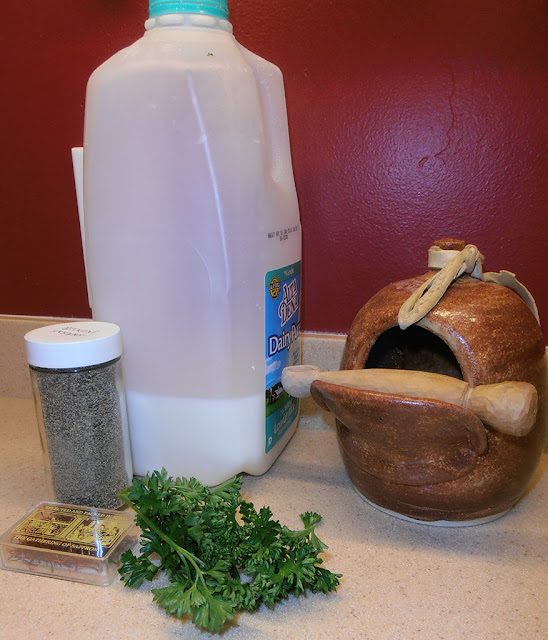The Prince of Transylvania’s court cookbook
From the 16th century
THE SCIENCE OF COOKING
You can find a copy of it here:
http://www.fibergeek.com/leathernotebook/files/2018/05/Transylvanian-Cookbook-v3.pdf
The recipes I have tried are here: Prince of Transylvania's court cookbook
This is recipe number 44, found on page 11.
Cow intestines stuffed with sweet milk.
Wash the intestines so that they will not smell; you will need sweet milk, eggs, saffron, black pepper, but mostly eggs. Mix these together, this is the stuffing. Add some parsley leaves to the milk, tie the two ends of the intestines so that the stuffing won’t leak. Poach it in hot water so that the milk will get dry like a liver. If you’re cooking it, cook it in another pot of clean water, once cooked, pass the water through a strainer, pass some sweet milk through a strainer on top of it, put some parsley leaves on it and cook it like that. Add some saffron half an hour before serving it, add some black pepper and salt.
You can view my redaction here.
Today I will tell you the results (in other words, I ate them!) of the sausage-making adventure.
When I considered the instructions, I decided that first you cook the sausages in water, and then make a sauce (of sorts) in which to further simmer the sausages and possibly serve them in it.
The sauce ingredients
1/2 cup hot water from simmering the sausage
5 threads saffron
1 cup milk
1/8 teaspoon salt
1/8 teaspoon pepper
1 tablespoon chopped parsley

I put the bigger of the two sausages into a pan with just enough water to cover it and simmered it until I thought it was heated all the way through. When the water started to simmer, I took out 1/2 cup, strained it, and put the saffron in it to steep.
 |
| Simmering sausages! |
Then I poured the water off the sausage, rinsed and cleaned the pan, wiped the foam off the sausage, and put the sausage back in the pan. I poured the milk mixture over it and brought it to a slow simmer, turning the sausage over once.
 |
| Not a lot of sauce in which to simmer. |
I put the whole sausage on a plate and cut it into serving-sized pieces. I garnished it with a little more parsley but it didn't seem to matter.

The Verdict
I served it as it was. The focus was on flavor and texture.
First, the sausage casing was rubbery and difficult to cut. I have since learned from my online friends that I should have let the sausages sit uncovered in the refrigerator for 24 hours to fix that problem.
The filling was soft, with bits of the seasonings either at the top (parsley floats) or at the bottom (pepper sinks) and nothing in between.


The texture was strongly reminiscent of flan -- a very delicate, fine-textured custard. It was the texture I had hoped to achieve when I first envisioned this recipe.
The flavor was very bland. I could not taste the seasonings except when I chewed on a piece of casing. This was okay sometimes but other times I got a blast of pepper, which I did not enjoy.
Overall, the group impression was, "Meh." Not interesting. I found myself thinking of flan even more as I ate it, and wishing there was a caramel sauce over the top. (Not that it would go with the parsley or pepper.)
I would call it a success in that the recipe turned out as I expected. But we did strategize on how to improve the eating experience for the rest of the sausages and for if I made it again.
For Eating the Rest
I took several pieces and fried them, like regular sausages, in olive oil. That crisped up the casings but did nothing to make the flavor exciting.
Then I cut up the rest of the pieces and cooked them with chopped ham and cubed cheddar cheese.

This was tasty but why not just put the ham and cheese with scrambled eggs? Why go to the trouble of making these sausages?
For Making It Again
My first thought was to make the filling more like scrambled eggs, so possibly make it 2 parts eggs (or more) to 1 part milk. That might keep the seasonings better distributed in the filling, too.
The next idea was to simmer the spices in the milk first to flavor it, then let the milk cool before mixing it with the eggs.
I also thought it would be interesting to make it more flan-like by making it sweet and use spices like cinnamon, and then serving it with a thin caramel sauce. A dessert sausage! Quite the sotelty, I think.
It Was Asked
My guest tasters asked, "Why do you think this was made in the first place? What made this recipe important enough to be included?"
My guess is that it is intriguing. It is a pretty sausage to look at, with the yellow and the speckles of seasonings. That is enough to get a guest's attention. And then when you discover it is a sausage filled with eggs (or custard) instead of the usual meats, that can cause discussion. I think if I could fathom the right egg-to-milk ratio and get the seasonings to distribute well, it could be a very tasty treat on my guests' plates.
I won't make any promises, but if I do this recipe again, I will report on it. I do still have plenty of sausage casings left over!
UPDATE: My friend, SS, believes this recipe might have been invented as a food for Lent. It would make a meal more like you were eating meat, giving variety to an otherwise repetitive diet. I think that is an excellent observation.

























